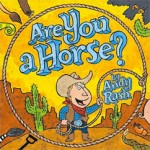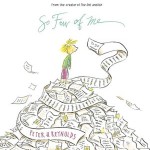Are You a Horse?
 Roy gets a saddle for his birthday with the instructions to find a horse and enjoy the ride, but Roy doesn’t know what a horse is. Are You a Horse? by Andy Rash had my group of kindergartners giggling and chiming in each time Roy asked a different character his big question. “Are you a horse?” Roy asks a cactus, but it can’t be a horse because it’s not an animal. Roy asks a snake, but even though it’s an animal, it can’t be a horse because a horse has legs. Time after time, Roy uses what he’s learned and finds a new something to ask, “Are you a horse?” only to be told no. Finally he finds an animal that meets all the requirements (an animal with legs, friendly, fast, no stripes, etc.) – yes, it’s a horse! The last page had those kindergartners guffawing, because Roy and the horse do use the saddle to go for a ride, but the horse rides Roy.
Roy gets a saddle for his birthday with the instructions to find a horse and enjoy the ride, but Roy doesn’t know what a horse is. Are You a Horse? by Andy Rash had my group of kindergartners giggling and chiming in each time Roy asked a different character his big question. “Are you a horse?” Roy asks a cactus, but it can’t be a horse because it’s not an animal. Roy asks a snake, but even though it’s an animal, it can’t be a horse because a horse has legs. Time after time, Roy uses what he’s learned and finds a new something to ask, “Are you a horse?” only to be told no. Finally he finds an animal that meets all the requirements (an animal with legs, friendly, fast, no stripes, etc.) – yes, it’s a horse! The last page had those kindergartners guffawing, because Roy and the horse do use the saddle to go for a ride, but the horse rides Roy.
There’s a great deal of “yes/no” information in this book, so it was the perfect story to teach kids how to use a chart as a graphic organizer. I made a chart with all the characters Roy meets (the cactus, the snake, etc.) going down the side. Across the top of the chart were listed all the characteristics that came up in the book: are you an animal, do you have legs, etc. Next, I put the picture of each character on a 3×5 card. To make sure I had enough for everyone in the class, I made three cards for each character. I passed out the index cards and asked the kindergartners to find the people who had matching cards (the cards had both the picture and the words to help my non-word-readers). Once the kids were sitting with their character buddies, we filled out the chart together on the Smart Board.
“Are you an animal? Cactuses, thumbs up if yes you are an animal, and thumbs down if you’re not.” Because the kids were in little teams, they could look to each other to answer the question. “Noooo!” Since the cactus did not meet the animal requirement, we wrote the word “no” with a frown face in that square. “Crabs, are you an animal?” Thumbs up meant we wrote the word “yes” with a smiling face in that square. If we weren’t certain (do crabs lay eggs? Good question!) we marked those squares with a question mark and decided to find out the answer during library time. As a group, we used the chart to review and organize all the information we’d learned in reading Are You a Horse? and all the students were actively involved. My animal-loving “nature smart” kids were thrilled, my “logic smart” kids were in heaven, and I had a blast listening to a classroom of kindergartners asking in their best cowboy drawl, “Are you a horse?”
For more information, visit Andy Rash’s website: rashworks.com.
Read More
So Few of Me
 “Leo was a busy lad. No matter how hard he worked, there was always more to do.” This time of year, I can totally relate to Leo in Peter H. Reynold’s wonderful book, So Few of Me. Some days, I wish I had what Leo had to help – another Leo. In fact, the busier he gets, the more Leos show up to lend a hand. But, more Leos find more and more things that need to get done. By the time the tenth Leo shows up to tackle the ever-growing to-do list, original Leo needs a nap, even though “dreaming was NOT on the list!” Leo realizes, “what if I did less – but did my BEST?” and gives himself time to dream.
“Leo was a busy lad. No matter how hard he worked, there was always more to do.” This time of year, I can totally relate to Leo in Peter H. Reynold’s wonderful book, So Few of Me. Some days, I wish I had what Leo had to help – another Leo. In fact, the busier he gets, the more Leos show up to lend a hand. But, more Leos find more and more things that need to get done. By the time the tenth Leo shows up to tackle the ever-growing to-do list, original Leo needs a nap, even though “dreaming was NOT on the list!” Leo realizes, “what if I did less – but did my BEST?” and gives himself time to dream.
Even little ones can relate to that overwhelmed feeling Leo feels in So Few of Me. Leo’s strategy of to-do lists is a good one to model and teach our kids. Now when I do storytimes, even with the 2-year-olds, I have a list that they can see of all the things that will happen during our time together. I made strips with words and pictures that say things like “book” and “song” and I hot-glued magnets to the back so I can stick them on my white board (I save the free magnets from pizza parlors and insurance agents to cut up and glue on). I pull off each activity as we do it so little ones can see how our time is passing. This visual plan is especially helpful for those who have trouble with transitions.
When my own kids were little and we had errands to run, it helped them to have a list for them to hold where they could check off items as we accomplished them. To avoid frustration (and meltdowns at the grocery store or bank), I tried very hard not to squeeze in “just one more” errand and instead I’d stick to the list. Encourage your little ones to make and use lists of pictures and words. Don’t forget to save room on your to-do list for dreaming!
For more information, visit peterhreynolds.com.
Read More






